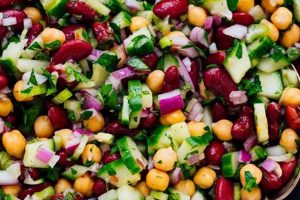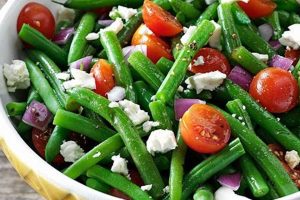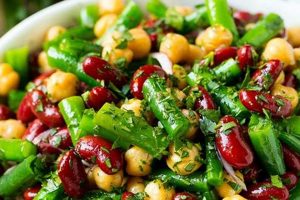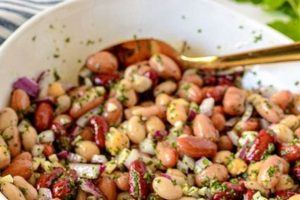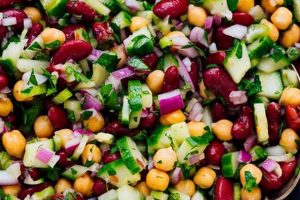A simple, nutritious dish typically composed of a mixture of five different varieties of beans, often canned or pre-cooked, combined with a flavorful vinaigrette. Common ingredients might include kidney beans, pinto beans, black beans, chickpeas (garbanzo beans), and cannellini (white kidney beans). The dressing often incorporates oil and vinegar, along with herbs, spices, and sometimes chopped vegetables like onions, bell peppers, or celery.
This type of salad offers several nutritional advantages. Beans are excellent sources of protein and fiber, both crucial for maintaining satiety and promoting digestive health. They are also rich in various vitamins and minerals, including iron and folate. Furthermore, the versatility of this dish allows for adaptations based on dietary needs and preferences; the dressing can be adjusted, different bean varieties incorporated, and additional ingredients like corn or fresh herbs can be added. As a cold salad, it’s ideal for picnics, potlucks, or as a light lunch or side dish. Its relatively simple preparation and long shelf life also contribute to its popularity.
The following sections will delve into specific ingredient recommendations, step-by-step preparation instructions, and suggestions for variations and serving options.
Tips for a Perfect Bean Salad
Achieving a well-balanced and flavorful bean salad involves attention to detail throughout the preparation process. The following tips offer guidance for optimizing both flavor and texture.
Tip 1: Rinse Canned Beans Thoroughly: Rinsing removes excess starch and sodium, resulting in a cleaner flavor and improved texture. Draining should be thorough to prevent a watery salad.
Tip 2: Consider Soaking Dried Beans: While canned beans offer convenience, dried beans offer a richer, more nuanced flavor. If using dried beans, follow proper soaking and cooking instructions to ensure optimal tenderness.
Tip 3: Balance the Vinaigrette: A well-balanced vinaigrette is crucial. Consider the acidity of the vinegar and adjust the oil and seasonings accordingly. A touch of sweetness, such as a small amount of maple syrup or honey, can enhance the overall flavor profile.
Tip 4: Enhance with Fresh Herbs and Spices: Fresh herbs like parsley, cilantro, or dill can brighten the salad’s flavor. Consider adding spices like cumin, chili powder, or smoked paprika for depth and complexity.
Tip 5: Add Textural Variety: Chopped bell peppers, red onion, or celery can add a satisfying crunch. Consider incorporating other vegetables like corn or chopped tomatoes for additional flavor and nutrients.
Tip 6: Chill Before Serving: Chilling allows the flavors to meld and enhances the salad’s refreshing quality. Allow the salad to chill for at least 30 minutes before serving.
Tip 7: Proper Storage: Store leftover salad in an airtight container in the refrigerator. Consume within 3-5 days for optimal quality.
By following these tips, one can ensure a delicious and satisfying bean salad experience. Attention to these details elevates the dish from simple to exceptional.
The following section offers concluding remarks and encourages culinary exploration.
1. Bean Variety
Bean variety is fundamental to a successful five-bean salad recipe. The selection of beans influences not only the nutritional profile but also the textural and flavor complexity of the final dish. Different beans offer unique characteristics; for example, kidney beans contribute a robust, earthy flavor and firm texture, while chickpeas provide a nuttier taste and creamier consistency. Black beans offer a mild, slightly sweet flavor, while cannellini beans have a delicate, buttery taste and a softer texture. Incorporating a diverse range of beans creates a more balanced and interesting culinary experience. A blend of kidney, pinto, black, cannellini, and garbanzo beans, for instance, offers a dynamic interplay of flavors and textures. Over-reliance on a single variety can result in a monotonous flavor profile and a less appealing texture.
Careful consideration of bean variety allows for tailored nutritional outcomes. Different beans offer varying levels of protein, fiber, vitamins, and minerals. Combining specific beans can maximize the nutritional value of the salad. For example, incorporating kidney beans contributes to higher iron content, while adding chickpeas increases the fiber content. Understanding the nutritional contribution of each variety empowers informed dietary choices. Moreover, the visual appeal of the salad benefits from a variety of bean colors and sizes, making it more enticing. The interplay of colors and textures enhances the overall sensory experience, making the salad more enjoyable.
Successfully navigating bean variety in a five-bean salad recipe requires attention to both culinary and nutritional goals. The choice of beans should reflect desired flavor profiles, textural complexity, and nutritional targets. A well-balanced mix of beans elevates the dish, offering a more satisfying and nutritious meal. Failure to consider bean variety can result in a bland and texturally uninteresting salad. Therefore, strategic bean selection is crucial for optimizing both the sensory appeal and the nutritional value of the final product.
2. Fresh Ingredients
Fresh ingredients play a vital role in elevating a five-bean salad recipe from simple to exceptional. While canned beans offer convenience, incorporating fresh elements enhances the overall flavor profile, nutritional value, and textural complexity of the dish. The strategic use of fresh ingredients allows for a more vibrant and nuanced culinary experience.
- Fresh Herbs:
Fresh herbs contribute brightness and depth to the salad’s flavor profile. Cilantro, parsley, dill, and mint are excellent choices, each offering a distinct aroma and taste. For example, cilantro adds a citrusy note, while parsley provides a clean, slightly peppery flavor. Freshly chopped herbs are preferable to dried versions, as they offer a more intense and vibrant flavor. The quantity of herbs can be adjusted based on personal preference, but a general guideline is to use about cup of chopped fresh herbs per recipe.
- Fresh Vegetables:
Incorporating fresh vegetables introduces textural variety and additional nutrients. Common choices include diced bell peppers (red, yellow, or orange for visual appeal), finely chopped red onion for a pungent bite, and diced celery for a crisp, refreshing crunch. Other options include chopped tomatoes, cucumbers, or corn kernels. These additions contribute vitamins, minerals, and antioxidants while enhancing the salad’s overall sensory experience. The choice of vegetables should complement the chosen beans and vinaigrette.
- Freshly Squeezed Citrus Juice:
Freshly squeezed lemon or lime juice adds a vibrant acidity that brightens the vinaigrette and complements the other flavors. This fresh acidity is preferable to bottled citrus juice, which often contains preservatives and lacks the same intensity of flavor. The amount of citrus juice should be balanced with the other vinaigrette ingredients to achieve the desired level of tartness. A general guideline is to use 1-2 tablespoons of fresh juice per recipe, adjusting to taste.
- Freshly Ground Spices:
Freshly ground spices offer a more pronounced and nuanced flavor compared to pre-ground versions. Consider grinding cumin seeds, coriander seeds, or black peppercorns just before adding them to the vinaigrette. This enhances the aromatic complexity of the salad and adds depth to the overall flavor profile. Freshly ground spices offer a more potent flavor, so start with a small amount and adjust according to taste.
The careful integration of these fresh ingredients elevates the five-bean salad recipe, resulting in a dish that is not only flavorful and nutritious but also visually appealing. The freshness of these components contributes to a brighter, more vibrant flavor profile and enhances the overall culinary experience. By prioritizing fresh ingredients, one can transform a simple bean salad into a truly exceptional dish.
3. Balanced Vinaigrette
A balanced vinaigrette is crucial for a successful five-bean salad recipe. It provides the acidic, savory, and sometimes sweet notes that complement the earthiness of the beans and any other added vegetables. The vinaigrette ties the ingredients together, transforming individual components into a cohesive and flavorful dish. A poorly balanced dressing can result in a bland or overly acidic salad, undermining the other carefully selected ingredients.
- Acidity
The acidity in a vinaigrette, typically derived from vinegar or citrus juice, provides a bright, sharp counterpoint to the richness of the beans. Common choices include red wine vinegar, apple cider vinegar, white wine vinegar, and lemon or lime juice. Each offers a distinct flavor profile, influencing the overall taste of the salad. For example, red wine vinegar adds a robust tang, while apple cider vinegar contributes a slightly sweeter note. The level of acidity should be carefully calibrated; too much can make the salad unpleasantly tart, while too little can result in a bland, uninspired dish. The acidity also acts as a preservative, helping to extend the shelf life of the salad.
- Oil
Oil provides the richness and body of the vinaigrette, balancing the acidity and carrying the flavors of the other ingredients. Common choices include extra virgin olive oil, avocado oil, and grapeseed oil. Olive oil offers a fruity, peppery flavor, while avocado oil has a milder, more neutral taste. The ratio of oil to vinegar is crucial for achieving the desired balance. A classic vinaigrette typically uses a 3:1 ratio of oil to vinegar, but this can be adjusted based on personal preference and the specific ingredients used. The oil also contributes to the salad’s mouthfeel and helps to coat the beans and vegetables evenly.
- Sweetness (Optional)
A touch of sweetness can round out the vinaigrette and enhance the other flavors. This can be achieved by adding a small amount of honey, maple syrup, or sugar. The sweetness should be subtle, complementing the other ingredients without overpowering them. For example, a teaspoon of honey can add a delicate floral note to a vinaigrette made with apple cider vinegar. The addition of sweetness is particularly effective when using more assertive vinegars, like red wine vinegar.
- Seasoning
Seasoning is essential for enhancing the overall flavor profile of the vinaigrette. Salt and freshly ground black pepper are fundamental, providing a savory base. Other seasonings, such as Dijon mustard, minced garlic, chopped shallots, or dried herbs, can add depth and complexity. The specific seasonings used should complement the other ingredients in the salad and the chosen vinegar and oil. For example, Dijon mustard adds a tangy, slightly spicy note that pairs well with red wine vinegar and olive oil. Experimenting with different seasonings allows for customization and the creation of unique flavor combinations.
A well-balanced vinaigrette is the key to a delicious and satisfying five-bean salad. By carefully considering the acidity, oil, sweetness, and seasoning, one can create a dressing that enhances the natural flavors of the beans and other ingredients, resulting in a cohesive and flavorful dish. The interplay of these elements elevates the salad from a simple side dish to a culinary highlight.
4. Proper Draining Technique
Proper draining technique is essential for a successful five-bean salad recipe. Excess moisture from canned beans, if not removed, can dilute the vinaigrette, resulting in a watery, less flavorful salad. Thorough draining ensures the beans retain their individual textures and absorb the dressing effectively, contributing to a more cohesive and palatable final product. This seemingly minor step significantly impacts the overall quality and enjoyment of the dish.
- Complete Removal of Canning Liquid:
Completely removing the canning liquid, which often contains excess starch and sodium, is the first step in proper draining. This liquid not only dilutes the vinaigrette but can also impart a metallic or slightly bitter taste to the salad. Emptying the can contents into a colander and rinsing the beans under cold running water removes this unwanted liquid effectively. The rinsing process also helps to separate the beans and remove any residual debris.
- Thorough Rinsing:
Rinsing the beans under cold running water serves multiple purposes. It washes away the starchy canning liquid, removes any lingering metallic taste, and helps to firm up the beans, improving their texture in the final salad. The cold water also helps to stop the cooking process if the beans were recently heated, preventing them from becoming mushy. Rinsing should continue until the water runs clear, indicating complete removal of the canning liquid and any residual starch.
- Effective Drying:
After rinsing, adequate drying is crucial to prevent excess moisture from seeping into the salad. Allowing the beans to sit in the colander for a few minutes helps to drain off excess water. Gently shaking the colander can further expedite the process. For optimal dryness, spread the beans in a single layer on a clean kitchen towel or paper towels and gently pat them dry. This extra step ensures the vinaigrette adheres properly to the beans, maximizing flavor absorption.
- Impact on Vinaigrette Emulsification and Flavor:
Proper draining directly impacts the vinaigrette’s effectiveness. Excess moisture can prevent the vinaigrette from emulsifying properly, leading to a separated dressing that doesn’t coat the beans evenly. This can result in uneven flavor distribution and a less satisfying culinary experience. Thoroughly dried beans readily absorb the vinaigrette, allowing the flavors to meld and create a cohesive, flavorful salad. The absence of excess moisture also helps to maintain the crispness of any added fresh vegetables, preserving the desired textural contrast.
By adhering to these draining techniques, one ensures the five-bean salad maintains its intended flavor profile, texture, and overall appeal. Failure to drain the beans properly can compromise the balance of the vinaigrette and negatively impact the final dish. This seemingly small step plays a significant role in the overall success of the recipe, contributing to a more flavorful and enjoyable salad.
5. Seasoning Adjustments
Seasoning adjustments are integral to a successful five-bean salad recipe. They provide the final layer of flavor complexity, balancing the inherent earthiness of the beans with complementary or contrasting notes. Strategic seasoning elevates the dish beyond basic ingredients, transforming it into a personalized culinary creation. This facet of recipe development allows for adaptability based on individual palates and desired flavor profiles.
- Salt and Pepper:
Salt and freshly ground black pepper serve as the foundational seasoning elements. Salt enhances the natural flavors of the beans and other ingredients, while pepper adds a subtle bite. The amount of salt should be carefully calibrated to avoid over-salting, which can mask the other flavors. Freshly ground black pepper provides a more robust flavor compared to pre-ground pepper. The interplay of salt and pepper creates a balanced savory base upon which other seasonings can build.
- Herbs and Spices:
Dried or fresh herbs and spices introduce complexity and depth. Cumin, chili powder, smoked paprika, oregano, and thyme are popular choices, each offering distinct flavor characteristics. Cumin adds a warm, earthy note, while chili powder introduces a touch of heat. Smoked paprika provides a smoky depth, whereas oregano and thyme offer more herbaceous, slightly floral notes. The choice of herbs and spices should complement the overall flavor profile of the salad and the chosen vinaigrette.
- Acidic Enhancements:
A splash of additional vinegar or citrus juice can heighten the brightness of the salad and balance the other seasonings. This can be particularly effective if the initial vinaigrette is perceived as lacking acidity. A small amount of red wine vinegar or lemon juice can provide the necessary lift. This adjustment should be made cautiously, tasting frequently to avoid over-acidifying the salad.
- Aromatic Vegetables:
Finely minced garlic, shallots, or red onion can add pungent, aromatic notes to the salad. Garlic provides a sharp, savory flavor, while shallots offer a milder, sweeter allium note. Red onion contributes both pungency and a pop of color. These additions can be incorporated directly into the vinaigrette or added to the salad separately. The quantity should be carefully considered, as these ingredients can easily overpower the other flavors.
Seasoning adjustments transform a basic five-bean salad into a customized culinary experience. The thoughtful application of salt, pepper, herbs, spices, acidic enhancements, and aromatic vegetables allows for a nuanced flavor profile that reflects individual preferences and complements the other ingredients. This flexibility ensures a delicious and satisfying final dish, tailored to specific tastes. The absence of thoughtful seasoning adjustments can result in a bland and uninspired salad, failing to capitalize on the potential of the diverse ingredients.
6. Chilling Time
Chilling time plays a crucial role in the development of flavor and texture in a five-bean salad recipe. Allowing the salad to rest in a refrigerated environment for a period of time permits the vinaigrette to permeate the beans, resulting in a more cohesive and flavorful dish. The chilling process also allows the flavors of the various ingredients, including herbs, spices, and vegetables, to meld and harmonize, creating a more complex and nuanced taste profile. For instance, a freshly made salad might taste bright and acidic, but after chilling, the flavors will mellow and integrate, resulting in a more balanced and palatable final product. The low temperature of refrigeration also firms the beans, enhancing their textural appeal. This is particularly noticeable with beans like kidney beans and chickpeas, which benefit from a firmer texture in a salad setting. Without sufficient chilling time, the salad may taste disjointed and the beans may have a less desirable, mushier texture.
The optimal chilling time for a five-bean salad is generally between two and four hours. This duration allows adequate time for flavor development and textural enhancement without compromising the quality of the fresh ingredients. Shorter chilling times may not allow for sufficient flavor melding, while excessively long chilling periods can lead to a loss of vibrancy in the fresh components, particularly delicate herbs and vegetables. Practical considerations, such as the time available before serving, may necessitate adjustments to the chilling time. In such cases, even a minimal chilling period of 30 minutes can offer some improvement in flavor integration compared to serving the salad immediately after preparation. For larger batches or salads incorporating more robust ingredients, slightly longer chilling times may be beneficial. Ultimately, the ideal chilling time depends on the specific recipe and desired outcome.
Understanding the impact of chilling time allows one to optimize the flavor and texture of a five-bean salad. This seemingly simple step elevates the dish from a collection of individual ingredients to a harmonious and well-integrated culinary creation. The practical application of this knowledge ensures a more satisfying sensory experience, maximizing the potential of the recipe. Failure to account for chilling time can result in a less flavorful and texturally appealing salad, diminishing the overall enjoyment of the dish.
7. Storage Methods
Proper storage methods are crucial for maintaining the quality, flavor, and safety of a five-bean salad. Appropriate storage preserves the freshness of ingredients, prevents bacterial growth, and extends the salad’s shelf life. Neglecting proper storage techniques can lead to spoilage, undesirable textural changes, and potential health risks. Implementing effective storage practices ensures the salad remains enjoyable and safe for consumption.
- Container Selection
Selecting an appropriate container is paramount. An airtight container is essential for preventing oxidation and maintaining the salad’s moisture content. A lidded container made of glass or food-grade plastic is ideal. Avoid using metal containers, as they can react with the acidic components of the vinaigrette, imparting undesirable flavors. The container should be of appropriate size to hold the salad comfortably without excessive air space, which can accelerate spoilage. Proper container selection preserves the salad’s freshness and prevents contamination from external odors or flavors.
- Refrigeration Temperature
Maintaining a consistent refrigeration temperature is crucial for inhibiting bacterial growth and preserving the salad’s quality. The ideal temperature range is between 34F and 40F (1C and 4C). Storing the salad at higher temperatures can promote bacterial proliferation, while excessively cold temperatures can damage delicate ingredients and negatively impact texture. Consistent refrigeration ensures the salad remains safe and palatable throughout its storage duration.
- Shelf Life
Five-bean salad typically has a shelf life of 3 to 5 days when stored properly in the refrigerator. Beyond this timeframe, the quality and safety of the salad may deteriorate. Factors influencing shelf life include the freshness of the ingredients at the time of preparation, the specific ingredients used, and adherence to proper storage practices. Observing the recommended shelf life minimizes the risk of consuming spoiled or unsafe food. Visual inspection and olfactory assessment can help determine if the salad remains suitable for consumption.
- Freezing (Not Recommended)
Freezing five-bean salad is generally not recommended. The freezing and thawing process can negatively impact the texture of the beans, causing them to become mushy. Furthermore, the vinaigrette’s emulsion can break down during freezing, resulting in a separated and less appealing dressing. While freezing may technically preserve the salad for a longer period, the compromised quality upon thawing renders it less desirable. Other preservation methods, such as canning, are more suitable for long-term storage if desired.
Implementing these storage methods safeguards the quality and safety of a five-bean salad, maximizing its shelf life and preserving its flavor and texture. Careful attention to container selection, refrigeration temperature, and shelf life guidelines ensures the salad remains an enjoyable and safe culinary experience. Neglecting proper storage practices compromises the quality and safety of the dish, potentially leading to spoilage and health risks.
Frequently Asked Questions
This section addresses common inquiries regarding the preparation and enjoyment of five-bean salad.
Question 1: Can dried beans be used instead of canned beans?
Dried beans can be used, but require pre-soaking and cooking. Soaking dried beans for at least eight hours, or overnight, reduces cooking time and improves texture. After soaking, beans should be rinsed and cooked until tender but not mushy. Properly cooked dried beans offer a richer flavor compared to canned varieties.
Question 2: How long does five-bean salad last in the refrigerator?
Properly stored, in an airtight container, five-bean salad typically lasts for three to five days in the refrigerator. Spoilage signs include cloudiness in the dressing, off-odors, or a change in the beans’ texture.
Question 3: Can five-bean salad be frozen?
Freezing is not generally recommended. Freezing can negatively impact the texture of the beans, often resulting in a mushy consistency upon thawing. The vinaigrette may also separate, compromising the overall quality of the salad.
Question 4: What can be added to five-bean salad besides the basic ingredients?
Numerous ingredients can enhance five-bean salad. Chopped bell peppers, red onion, celery, corn, fresh herbs (such as parsley, cilantro, or dill), and various spices (like cumin or chili powder) can add flavor and textural complexity.
Question 5: How can the vinaigrette’s acidity be adjusted?
The vinaigrette’s acidity can be adjusted by altering the ratio of vinegar to oil. More vinegar increases acidity, while more oil mellows it. A touch of sweetness, such as a small amount of honey or maple syrup, can also balance the acidity.
Question 6: Is five-bean salad a healthy dish?
Five-bean salad offers several nutritional benefits. Beans are excellent sources of protein, fiber, iron, and folate. The vinaigrette contributes healthy fats, particularly if olive oil or avocado oil is used. The specific nutritional content varies based on the chosen bean varieties and other added ingredients.
This information clarifies common points of interest concerning five-bean salad preparation and storage. Understanding these aspects contributes to a more informed and successful culinary experience.
The following section provides a concluding summary of the provided information.
5 Bean Salad Recipe
Exploration of the five-bean salad recipe reveals a dish offering both simplicity and nutritional value. Careful selection of bean varieties ensures a balance of textures and flavors. Fresh ingredients, such as herbs and vegetables, elevate the salad’s sensory appeal. A well-balanced vinaigrette, incorporating appropriate acidity, oil, and seasonings, is essential for a cohesive and flavorful final product. Proper draining techniques prevent a watery salad, while thoughtful seasoning adjustments allow for personalized flavor profiles. Chilling time allows flavors to meld, and appropriate storage methods maintain quality and safety.
Five-bean salad represents a versatile culinary canvas, adaptable to individual preferences and dietary needs. Its inherent simplicity belies a potential for culinary creativity. Further exploration of bean varieties, flavor combinations, and complementary ingredients offers opportunities for continued culinary discovery. Emphasis on fresh, high-quality ingredients and mindful preparation techniques ensures a consistently satisfying and nutritious dining experience.

